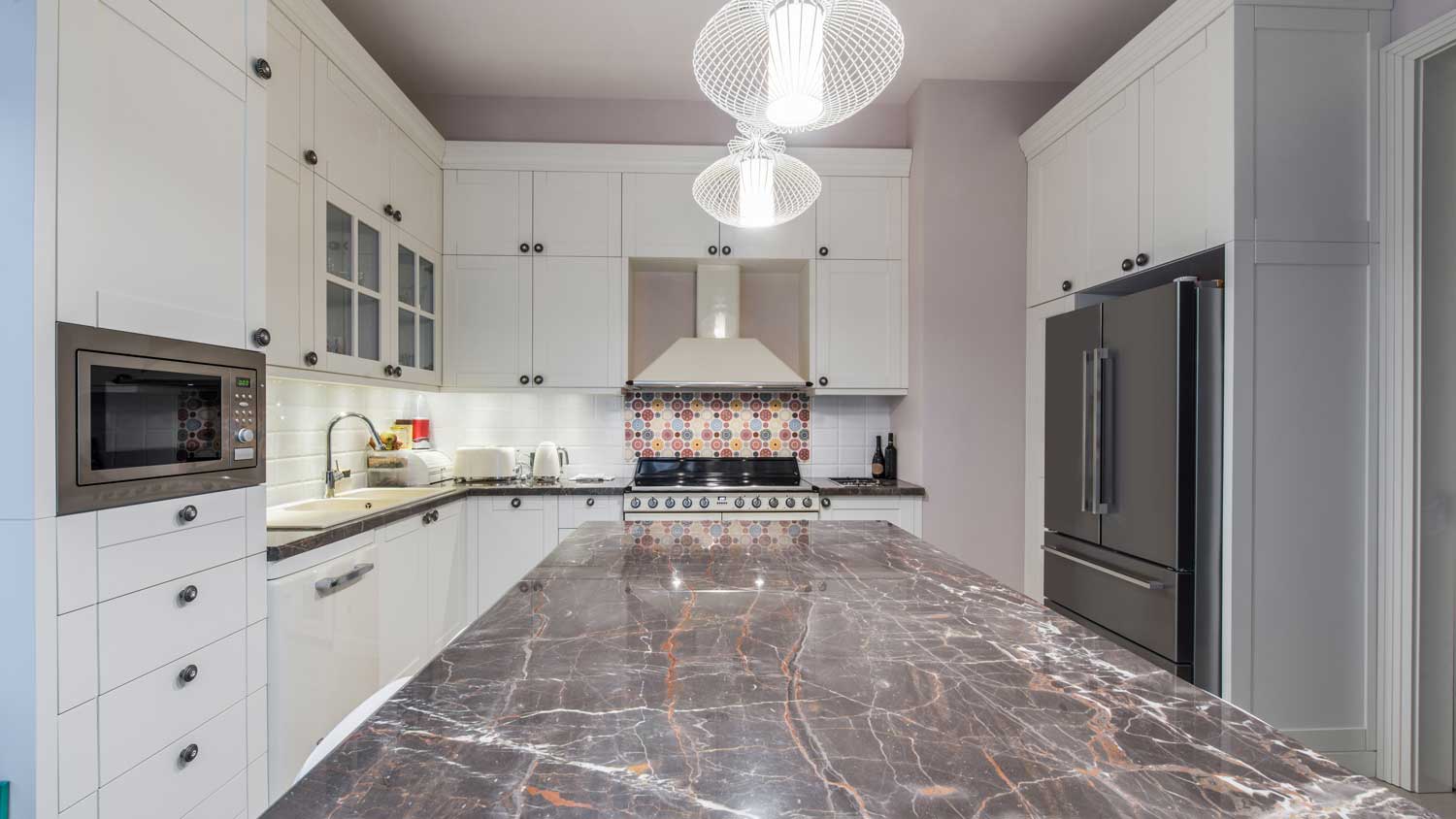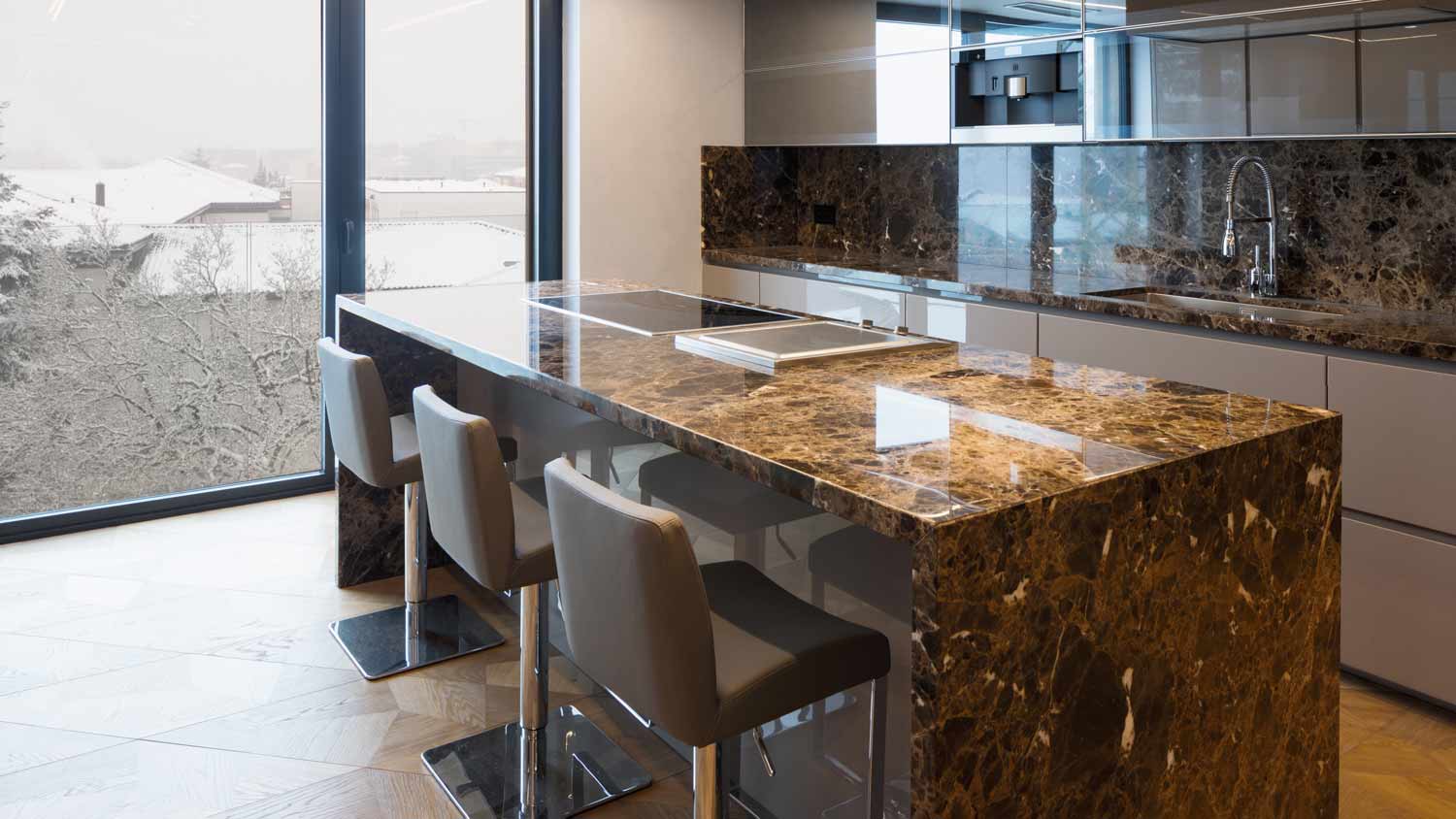Pros and Cons of Onyx Countertops for Your Kitchen
Colorful, lightweight, and downright dramatic


Onyx stone countertops consist of mineral deposits, creating a stunning, glowy look.
The material is fragile and expensive, costing an average of $40 to $250 per square foot.
The stone is not heat-proof or scratch-resistant, which could be problematic for busy kitchens.
Onyx comes in a broad range of colors, including black, gray, pink, and green.
If you are looking for a gorgeous stone countertop, onyx is a serious contender. Despite its name, the natural material comes in a broad range of shades that other stones can't seem to match. However, onyx requires more upkeep than other natural stones. Let’s explore the pros and cons of onyx countertops.
What Are Onyx Stone Countertops?

Onyx stone countertops are unique and have a different composition than quartz, marble, or granite. The material is formed of mineral deposits, creating a lovely translucency in unique patterns and shades. When backlit, it emits a warm glow, giving any space in your home a luxurious look.
But its good looks come with drawbacks. Onyx is lighter, more fragile, and softer than other types of stone. For homeowners, this means more careful maintenance for onyx countertops to retain their natural beauty.
When considering what material best suits your dwelling, consult a local stone countertop installer to help inform your final decision.
| Pros | Cons |
|---|---|
| Unique translucency | Soft and fragile |
| Heat resistant | Scratches easily |
| Lightweight stone | Expensive |
| Variety of colors | Not heatproof |
Pros of Onyx Countertops

While onyx countertops require extra care, many homeowners find them worth the effort because of their distinctive appearance and worthwhile investment.
Translucent
Its mineral composition sets onyx apart from denser stones like marble, granite, and quartz. Like mica, it's translucent, allowing light to shine through. When backlit, onyx produces an almost ethereal glow, enhancing the material's veining and patterns and adding drama to high-end home bar, kitchen, and bathroom designs.
Heat-Resistant
Homeowners opting for onyx countertops will enjoy the material's natural heat resistance. That means the stone can handle warm pans and pots for brief contact moments without discoloring or weakening. You’ll still need to use a trivet for hot pans right off the stove.
Lightweight
Onyx is significantly lighter than granite and quartz, making it easier to handle and install. Onyx's reduced weight means less strain on cabinetry and support structures, which can be particularly beneficial in remodels or when working with older cabinets that may not support the heavier weight associated with denser stones.
Variety of Colors
When it comes to onyx, no two slabs are alike. Thanks to centuries of mineral deposits, you can expect a broad range of twisty veins, bold striations, and a fluid-like appearance.
You can also look forward to an array of colors, from soft, creamy tones and earthy browns to high-impact shares of red, blue, green, and black. When polished to a high gloss, onyx reflects light beautifully, enhancing its visual appeal.
Cons of Onyx Countertops
Onyx countertops undoubtedly make a stunning visual statement. However, this material has drawbacks that savvy homeowners should consider carefully.
Soft and Fragile
Onyx is a delicate natural stone prone to chipping and cracking. Unfortunately, the material lacks the durability of granite or quartz, meaning extra caution is needed to prevent accidental damage. We suggest frequent sealing as part of the countertop's routine maintenance.
Scratches Easily
Since onyx is soft, it scratches easily. For busy home cooks, everyday kitchen activities can quickly leave marks on onyx countertops. Knives, cookware, and even rough cleaning sponges can produce visible scratches. The best way to avoid this is for homeowners to use cutting boards, trivets, and gentle cleaning materials.
Expensive
Onyx takes eons to form, making it a rare and exotic material with a high price tag. In addition to the cost of the material itself, specialized fabrication and installation may contribute to the overall expense, making it one of the priciest countertop options.
You should expect the cost of an onyx countertop to range from $40 to $250 per square foot, depending on your location and the size of the finished work. The rarest colors, like pink, can cost up to $355 per square foot. More common varieties, like gray and off-white, are more affordable.
Not Heatproof
While onyx is heat resistant, it cannot handle direct contact with extremely hot pots and pans. Placing searing-hot cookware on its surface can cause discoloration, cracks, or weakening of the stone, making trivets or hot pads necessary.
Onyx Countertop Alternatives
If you love the look of onyx but need a more practical, durable, or budget-friendly option, consider these options:
Quartzite is a natural stone with veining and elegance like onyx but is much more resistant to scratches, stains, and heat.
Engineered quartz offers the appearance of natural stone with superior durability and minimal maintenance, making it a budget-friendly choice.
Marble delivers a luxurious aesthetic with unique veining; however, it requires regular sealing to prevent stains.
Glass countertops can be backlit like onyx, providing a similar glowing effect while being more durable and easier to maintain.
Agate or semi-precious stone slabs are perfect for homeowners seeking something unique and striking with a visual impact similar to onyx but made of a stronger material.
Are Onyx Countertops Right for You?
Deciding if onyx countertops are right for your abode comes down to balancing aesthetics and practicality. The material can be a fabulous choice if you seek something truly high-end and are willing to take steps to maintain its beauty. Since the material is soft, you may also want to consider your lifestyle. For instance, it may not be the best choice for home chefs with busy kitchens.
Frequently Asked Questions
Onyx countertops are naturally porous, absorbing liquids and staining easily without proper care. Regular sealing every 6 to 12 months is essential to keep them looking their best. Daily maintenance includes wiping up spills immediately and avoiding harsh cleaners or acidic substances that can etch the surface.
Yes, onyx is more expensive than granite because of its rarity, delicate nature, and specialized care. Its luxurious appearance and ability to be backlit also add to the cost, making it a premium choice for homeowners.
While onyx is among the most expensive countertop stones, it’s not always the priciest. It is generally cheaper than Calacatta marble, which is highly sought-after for its rarity and bold veining. However, onyx still commands a premium price due to its unique translucency and delicate nature.















